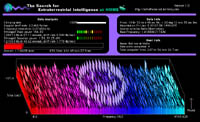|
Most likely, if there is an intelligent signal lurking around, it will be almost buried in the noise of your graph, probably invisible to the unaided eye, but glaringly obvious to the detailed analysis that your computer is doing. The billions of calculations you do will hopefully expose the message that we all dream is there. If you see some evidence of a signal on your screen it is very important that you NOT contact the media until the signal is verified and checked. False alarms severly damage the credibility of SETI@home and all serious SETI programs. Be patient. If there is a real signal, we promise to inform you and keep you "in the loop" concerning the progress of the search.
Click the thumbnail. If you see anything like this one, then you can get a little excited (and maybe a little frightened or disappointed, or both). You still can't get too excited though. Your discovery still has to go through a rigorous set of tests and verifications to prove that it's truly of extraterrestrial origin.
If your signal passes all of the tests and re-tests, then we'll all get excited!
|

|